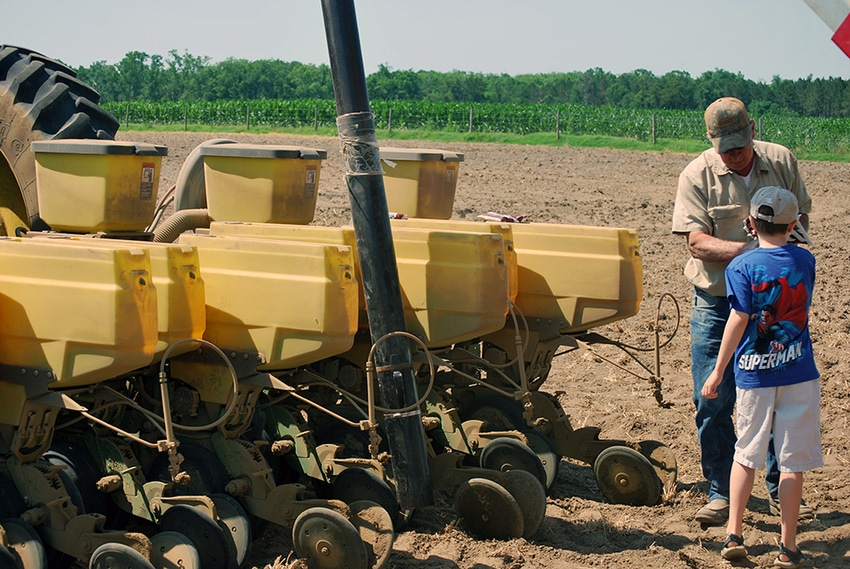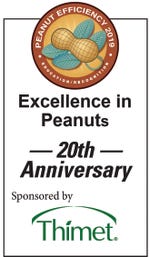
You could argue, without ruffling too many feathers, that the last 20 years provided fertile ground for unprecedented changes in the peanut industry.
Over the past two decades, the Farm Press Peanut Efficiency Award (previously known as the Peanut Profitability Award) has annually championed the best peanut farmers across the different peanut-producing regions of the United States, highlighting what they do, how they do it and who they are.
The program will celebrate its 20th class of winners at this year’s Southern Peanut Growers Conference, which returns to Panama City, Fla., in July. For the past 19 years, the program has honored three peanut farming families, one each from the Upper Southeast, the Lower Southeast and the Southwest. This year, Farm Press added a fourth region to the program, the Delta, to highlight the growing and unique production in that part of the country.
With this article, Southeast Farm Press begins an editorial series called ‘Excellence in Peanuts – A 20th Anniversary,” which will explore the last 20 years of U.S. peanut production through the lens of the peanut efficiency program.
The series will include five installments and appear in the five Southeast Farm Press print issues leading up to the Southern Peanut Growers Conference, and on Farm Press sites.
Much has changed in the U.S. peanut industry over the last two decades. In the late-1990s when the Farm Press Peanut Profitability Award program began, the national average peanut yield hovered around 2,600 to 2,700 pounds per acre. Today, 4,000 pounds per acre is the norm with many growers hitting three tons or greater per acre consistently with both runner and Virginia types, and newer high-oleic varieties promise equally higher yields.
The Variety
Georgia is the country’s leading peanut state, and 20 years ago there were an estimated 7,000 Georgia peanut growers. Today, there are an estimated 4,500 Georgia peanut growers, according to the Georgia Peanut Commission. Peanut acreage has remained about the same in the state, so fewer growers now manage more acres each than they did 20 years ago.
To help paint the picture of peanut production 20 years ago and compare it to today, Farm Press got up with Dr. John Beasley, a long-time and well-known peanut agronomist with the University of Georgia and current head of Department of Crop, Soil and Environmental Sciences at Auburn University. It was a fun conversation.
Tomato spotted wilt virus was the first thing that came to Beasley’s mind when he placed it back to 1999, and that isn’t surprising considering he was a UGA Extension peanut specialist then. The disease had rumbled a shockwave through the runner peanut industry in the mid-1990s, but new research efforts and cultural practices, such as seeding rates, planting dates, tillage, variety selection and other means to handle the problem hit full stride that year, including the mass availability to growers of the Georgia Green variety. The UGA breeding program release showed exceptional resistance to the disease, and coupling the variety with a twin-row pattern, research revealed, could boost yields by 500 pounds to 1,000 pounds per acre.
But there was a catch: peanut shellers didn’t care much for Georgia Green, which they said didn’t play well with current shelling practices or equipment, “but once the growers saw its resistance to spotted wilt and its yield potential, they said, ‘Hey, we must have this.’” Georgia Green stuck and the industry evolved, and as time passed shifts were made to newer improved varieties, which continue to this day.
Unlocking Future
Though it remained a concern, the industry shook off spotted wilt, found solid ground, and a peanut yield revolution began, which marches on today. And as the new century began, some might have dreamt, but few likely predicted, that within the next two decades the mysteries and opportunities within the peanut genome would be unlocked.
The U.S. peanut market, as 2000 grew older, was still under the decades-old, government-managed quota system, but it would not be for much longer. Within two years, the quota system would be phased out in preference of today’s more open-market system, which unbolted the path to the expansion of peanut acres in new regions, and peanut growers had to learn how to be better peanut marketers. And they did.
“Round-up ready cotton was just being introduced back then, too, and that technology in cotton changed how we approached weed management for all crops in the Southeast, including peanuts,” Beasley said, noting that growers over the following years would learn a lot more about herbicide resistance, whether they wanted to learn it or not.
Technology has changed farming for all in the last 20 years, including peanut farmers. Where once two-row diggers and harvesters worked 15 or so acres a day dumping into 14-foot trailers, self-propelled six- or eight-row machines with on-the-go dumping get five times more done in a day.
And early stages of computer modeling and irrigation scheduling were being honed, such as at the USDA National Peanut lab. At the time, Beasley said, and surveys showed fewer than five percent of farmers used or had regular access to PC computers; again, that wouldn’t last long.
“I like to say most farmers skipped over computers and landed on smartphones,” Beasley said, noting that growers, young and seasoned alike, now control more from the cab of their tractors or from the screens of their smartphones than few believed possible 20 years ago.
Beasley said people who were around at the time know, but it is worth remembering again: between about 1986 well into 2002, much of the U.S. peanut belt struggled under drought conditions. But in 2003, new approaches and techniques learned through the spotted wilt years, coupled with major advances in technology, met perfect weather, and the 2003 peanut crop rejuvenated much needed returns and capital investments by growers ready to keep the momentum going.
Twenty years ago, peanut farmers had only a handful of disease management products at their disposal. Today, Dr. Bob Kemerait, University of Georgia Extension plant pathologist and a leading expert of peanut diseases in the country, says U.S. peanut producers have available “one of the best (and largest) arsenal of products to use against peanut disease they have ever had.”
The Peanut Efficiency Award data remain confidential, but is archived by Dr. Marshall Lamb, economist and head of the USDA National Peanut Lab in Dawson, Ga., who also is the primary adviser for the PEA program. This series will pull from that vast data set to help quantify and tell the story of the evolving peanut production in the U.S. over the last 20 years. We plan to touch back with previous winners from the Southeast and Southwest to see how things are going for them today. Stay tuned.
About the Author(s)
You May Also Like






